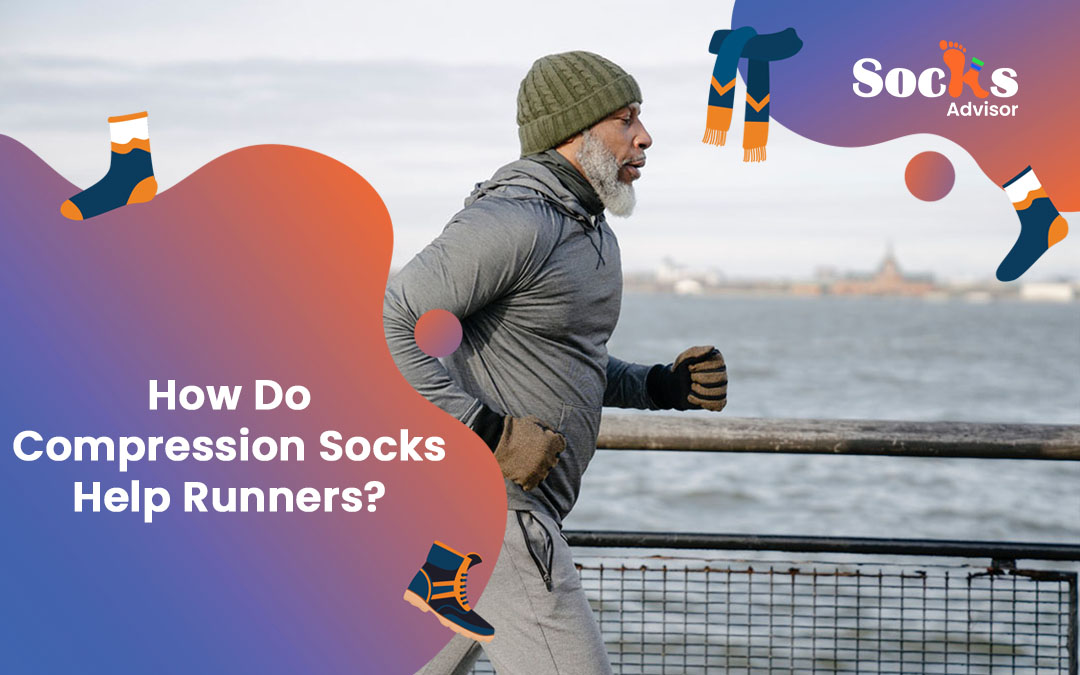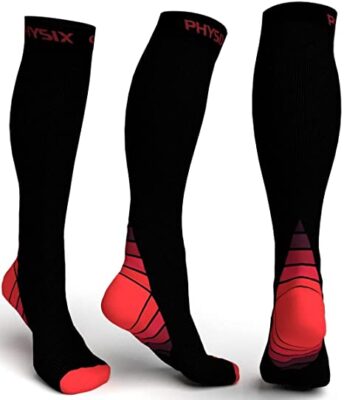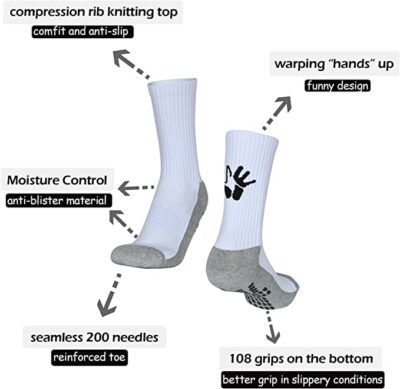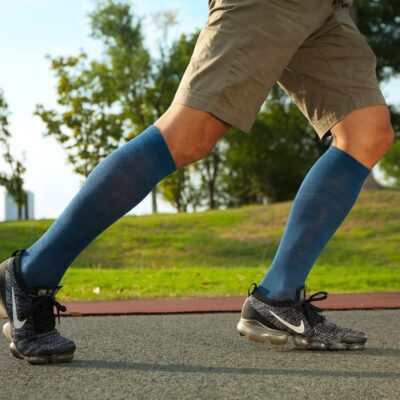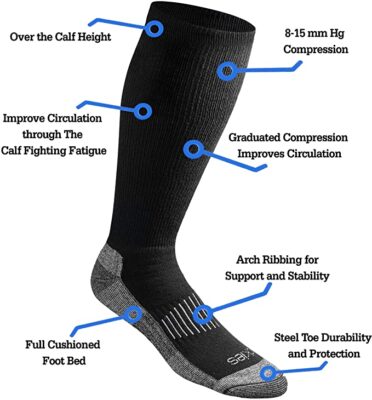Has the buzz about compression socks affected your nerves as well? Your presence in this article indicates to me so. At times in our lives, we collide with an object that we can’t really get off our minds. And with the compression socks, I am feeling the same. Every atom of my body is in an anxious state to get through the answer on what compression socks are. And how do compression socks help runners?
Before penning this article I came across various research studies. At first, I was confused by the study’s conclusions. Because some of them were favoring the statement that compression socks do help runners. While some evident no improvement at all.
Are Compression Socks Worth Buying? What You Need to Know Before Purchasing:
Although the results are vague. Whoever wore the compression socks did not deny their benefits. Except for the ones who have been suffering from diseases like ischemic. A condition when the heart does not receive enough blood and is common during high-end activities like running.
This is why wearing compression socks for performance purposes is a personal but confident choice. In consideration of the statement made by Dr. Botek.
She defines the socks as an “underutilized option” looking at the tempting benefits it gives but the compression offering frequency can vary from model to model.
I strongly acquire your attention on the compression socks’ sizing and the magnitude of compression before you decide to buy them because the wrong size can lead you to itch, redness, swelling, the not so pleasant compression marks, and improper blood flow as well.
Let’s have a detailed look at the essentials you need to know about compression socks. And whether are they worth buying.
- Are Compression Socks Worth Buying? What You Need to Know Before Purchasing:
- What are Compression socks?
- How do Compression socks for runners work?
- How do Compression socks help runners? The Top 7 Benefits:
- 1. Fasten the oxygen supply:
- 2. The design doesn’t let gravity pour in
- 3. Supports Lactic Acid breakdown:
- 4. Don’t let yourself be tired:
- Quick Tip for You!
- 5. Reduced Swelling in feet, ankles, and legs:
- 6. Protect legs from abrasions, dirt, and scratches on the ground
- 7. Perfect leg hugging for the winter:
- Compression socks Performance – A light shed in accordance with the Human Kinetic Journal experiment:
- Types of Compression Socks
- Tips on How to choose a compression sock:
- Compression socks vs compression sleeves. What’s the difference?
- Final Verdict
What are Compression socks?
“Compression stockings are fabric socks of various lengths and possess enough elasticity to stick around your legs without slipping off. And they improve blood circulation while you are high on activity. Such as during endurance events such as running or triathlons”
These socks gently squeeze around your calf and compress the surface veins by applying pressure. And leaving the way for blood to circulate. But it’s no lie that a greater magnitude of compression can also seize the blood flow. So a gentle reminder here is to have a thorough look at its sizing. The motive here is to support and not to constrict.
These socks are really good at lowering the pain, waning the swelling and aching. And are also very effective at preventing serious medical conditions. Great at preventing DVT- Deep Vein Thrombosis. A phenomenon where a blood clot is formed in one or more deep veins of the body.
How do Compression socks for runners work?
Your memory neurons might have come into action after reading the above paragraph. And would have made you wonder how compression (the tightening of feet)can allow the way for blood to circulate smoothly. Well, do not fear, because the phenomenon involved behind it is simple. And I would try to explain it to you without sounding like your biology teacher.
Human Heart works to circulate blood- a statement that is infused in our minds since childhood. But how it circulates is a process that didn’t really make its way. Which is why it’s good to revise it.
Understanding – How feet tightening can smoothen the blood flow?
The heart pumps the oxygen-containing blood into the muscles and limbs by means of the carriers. Termed arteries, these muscles then use that oxygen-rich blood for their purposes. And after utilization send the deoxygenated blood (Blood without oxygen) back to the heart. By means of second carriers which are termed as veins.
The deoxygenated blood is filtered and converted into oxygenated form again and the process continues till our last breaths. This is why continuous oxygen supply is essential for the proper functioning of the human body.
Ok, so we are done with how blood circulates. Now let’s move to the compression socks role in them.
So, Compression socks are built so that they apply gentle pressure in a controlled amount at the ankle and it then decreases on the upside of the leg which is most probably the knee area. Since running requires more stress on the ankles this is why pressure on this area is high
This pressure forces the muscles to constrict so they can push up the fluid (blood) in your cells by compressing the veins that are surrounding them. Veins then take the deoxygenated blood to the heart and the filtration process initiates and in turn, you get more oxygen.
This pushing of the blood to the veins gets faster with compression socks.
How do Compression socks help runners? The Top 7 Benefits:
1. Fasten the oxygen supply:
Compression socks help direct the muscles to squeeze the deoxygenated blood into the veins by applying a controlled amount of pressure. The veins then supply the no-oxygen-containing blood to the heart. It filters and oxygenates the blood, and send it back to the muscles via arteries. This way the muscles get the oxygen faster thus increasing your stamina and footfall.
2. The design doesn’t let gravity pour in
Yes, the compression socks do cut down the gravity, and being a runner you can understand how important is to swiftly battle gravity for a smooth faster run. Their design helps them at achieving this cause.
These socks are kept tighter at the bottom i-e near the ankle and they loosen up on the top i-e near the knee. This way the pressure that these socks generate on the ankles directs the ankle’s muscles to push the blood upward and thus increases the blood circulation.
And increased blood circulation is what you need at running so that you don’t feel tired or snugged out.
3. Supports Lactic Acid breakdown:
Lactic Acid is a biochemical that our bodies produce during the absence or low rate of oxygen availability to convert glucose into energy.
This process is termed anaerobic respiration or lactic acid fermentation and is the opposite of the body’s normal respiration where glucose breakdown is done in the presence of oxygen so the body can get energy.
For your understanding:
Glucose is a carbohydrate that we intake via food and is broken down by our body’s enzymes into ATP- which is the human body’s energy unit.
When you run, due to the faster rate of respiration oxygen availability lowers and so does your rate of energy level. This is the reason why you feel tired and out of breath after a long run. So, the low availability of oxygen triggers anaerobic respiration (because obviously, you need something to be alive).
If this process continues for longer, the lactic acid- a by-product of anaerobic respiration starts to accumulate in your muscles and cause cramps, pain, swelling, and soreness in some conditions, the prolonged run can lead you into lactic acidosis- A condition in which lactic acid accumulates in the blood and disrupt blood flow.
Wearing compression socks can easily cut down on these issues because the contractions that these socks provide force ( in a good way) the muscles to squeeze out the lactic acid and break it down into energy thus freeing you from the muscles’ soreness and cramps.
4. Don’t let yourself be tired:
Not one but many factors can take a part in making you tired but our concern of discussion here is the reduction in the movement of the calf muscles.
The calf muscles are built from the three muscles. They are the triceps square and include
- Gastoceminus
- Soleus
- Plantaris
These three calf muscles connect at the Achilles tendon which in turn directly connects to your heel. Now, why are we knowing this? Because these muscles carry any leg or foot movement and the greater use of these muscles leads to tiredness?
Thus wearing compression socks minimize these movements and relieves the body from the motion stress so you can enjoy easier longer and fatigue-free walks.
Quick Tip for You!
If you ever feel tired of running, try out this-
Your body doesn’t support you on a run mainly because of the absence of carbohydrates. They are the body’s primarily felicitous fuel tanks and the above-mentioned anaerobic process evidence it. In short, the more the carbohydrate intake before your running sessions, the greater the duration of the run you will experience due to a greater number of energy units (Glucose) breakdown.
5. Reduced Swelling in feet, ankles, and legs:
Huh! Looks like this article is loading with science but that’s how our bodies work buddy. Sorry to burst your bubble but the more you are clear on the compression socks, the better will you make a purchase.
Swelling in our bodies is linked with the fluid accumulation inside the muscles. Swelling is actually good for your body because it’s the indication that immune cells- the lymphocytes had reached the site of infection.
And have initiated their work of treating however their treatment can be fastened by the use of compression socks that don’t let the fluids build up and prevent excessive swelling than the required.
6. Protect legs from abrasions, dirt, and scratches on the ground
Stocking up the tingles of grass while on a run is a not-so-pleasant activity. Also, the exposed legs can lead to abrasions and scratches, and severe injuries during falls, and fall during the run of high velocity
Because your body can’t bear the sudden stoppage due to inertia. Another reason to wear compression socks is that they protect your legs and feet from the sun and reduce the chance of building up a suntan.
7. Perfect leg hugging for the winter:
Not just for runners but compression socks are the perfect leg hugging for all of us. During the winter, however, it’s not really a good option to pressurize your calf muscles until it’s required. But yes compression socks do provide warmth and work really well at preventing muscle strain.
This provided warmth is also great at speeding up the recovery time for injuries in winter. However, don’t be afraid by thinking of this warmth for the summer season because compression socks come in both cotton and wool material for winter and summer.
Compression socks Performance – A light shed in accordance with the Human Kinetic Journal experiment:
The human kinetic journal carried an experiment to clear out the fuss on the compression socks’ performance and the result they got is filled with amusement.
Purpose of the experiment:
The motive behind the experiment was to determine the effect of wearing compression socks between repeated running bouts that they checked on perceptual, physiological, and performance-based parameters.
What did they do?
They took the twelve well-trained male runners and recorded their perceptions of the efficacy of compression socks. Two experimental sessions were conducted and each session included a 5km running time trial on the treadmill. 1 hour of recovery time was allotted to the runners in between the two sessions.
They kept a randomized cross-over design by letting the participants (required) wear the compression socks during the recovery period while compression socks were not worn between the other sessions.
The Result:
In a shocking turn of events, the running performance of those who wore compression socks was higher in the second session compared to those who were not allowed to wear them. Also, their efficacy measurements were grouped with the compression socks and it showed that participants showed improvement.
The result also showed reduced muscle soreness and swelling during the recovery period however the fatigue rate did not show a piece of major evidence.
What can we conclude from the experiment?
This experiment clearly shows us that wearing compression socks does increase the runner’s performance by letting him cut out from muscle soreness, swelling, and pain and also by allowing the proper blood flow that makes it easier for him to stay on the run.
Types of Compression Socks
Types of compressions socks are three
- Graduated compression stockings
- Anti-embolism stockings
- Non-medical support hosiery
Let’s see how these three are different and how they can benefit you.
1. Graduated Compression Stockings- Our Recommendation for the runners
These socks have the strongest level of compression. What they do is that they provide more compression on the ankle and the level gradually decreases while it moves upwards towards the knee. Well, this is how we expect the compression socks to be.
No doubt, such a compression level plays a great role in mobility and helps to prevent medical conditions like Peripheral edema which is a condition in which swelling of the foot or arms occurs because of being in one position for longer.
These compression socks also efficiently cut down on lower leg swelling because they don’t let the fluid build-up ( this feature we all expect from all kinds of compression socks). By the way, this one ends just below the knee.
It has another stocking type that extends to the thigh and it helps to reduce the accumulation or pooling of the blood. This protects you from orthostatic hypotension. A condition in which they measure low levels of blood.
Didn’t we just learn most of the scientific terms and diseases today?
Graduated stockings are available in different colors, a choice for open-toe or closed-toe is also provided. Choosing a type is entirely a personal dependence.
2. Anti-embolism Compression socks:
Anti-embolism compression socks are the second type of compression socks and they work by providing a gradient compression and their level of compression differs.
These socks are most liked for reducing the risk of deep vein thrombosis. A phenomenon that we already discussed in the above paragraphs.
They are a choice of people who are not so involved in high mobile activities. Definitely not a good recommendation for runners.
3. Non-Medical Support Hosiery:
The type three compression socks. This one is built with the inclusion of an elastic support hose that provides uniform compression and puts less pressure on the feet in comparison to the others.
These compression socks can be used daily if you are someone who faces issues of tiredness and aching around the legs. Because of the safe amount of pressure put on the legs, these socks do not require any medical prescription and are easily available at pharmacy stores.
Tips on How to choose a compression sock:
The varietal changing frequency of today’s market is getting faster day by day and with such a frequency and variations available, it gets difficult to choose the right piece.
Compiled below are some of the factors that you should keep in mind before buying compression socks. You can cut down on some and keep some but you can also try to pick a piece that has all the below-mentioned factors if your budget doesn’t interrupt because it does when I am out buying.
Keep note of the size:
Make sure it’s neither too long nor too short. The magnitude of compression has a good link with the sizing. The tighter the socks the more compression will add and great compression may reverse the benefits of these socks. Make sure they don’t bunch or sting your legs
Go for the graduated stockings because they have a higher constriction level around the ankle and low levels towards the top. This helps runners achieve greater success dimensions.
Look for the pull-on closures. It really helps with putting up the socks. The slip-free feature would be the icing on the cake.
Experts recommend a compression rating of 20-30mm/Hg is high for runners.
Look for features:
Compression socks help with features like moisture-wicking, odor resistance, and breathability. Also, look for Heel and toe reinforcement, inline padding, and cushioning around the heels, toe, and top of the foot will make running easier and more comfortable
Seamless technology insertion would be a great choice for running because your legs will be on the duty of increasing blood circulation and yet you would feel nothing.
Make sure the socks don’t itch, snag or redden your legs and also have a look at washing instructions as well. because ignoring them might cost you socks shrinkage.
Compression socks vs compression sleeves. What’s the difference?
Compression socks and compression sleeves both come under the major category the compression gear but how do compression socks help runners and do the latter help them as well is the point of reflection here.
The sizing and pressure-putting points of these two compression gears are the major points of differentiation here.
“Compression sleeve is a fabric that you wrap around your legs from the length of ankles to the knees without covering the feet. They help at recovering the muscles from the previous activity and support quicker blood flow to the heart by contradicting the muscles”
While
“Compression socks help by wrapping around your entire feet till the length of the knee or its size can vary but the insertion of feet is for sure. They also help at improving the blood flow”
Why Compression Socks are a Better Choice than Compression Sleeves for Promoting Blood Flow:
From the definitions, we know that both of them are designed to pump up the blood flow but studies reveal that compression socks are actually a better choice. Because of the controlled amount of pressure it applies.
It pressurizes the ankles while the compression sleeves provide the compression at the point of the product end. Thus it can lead to blood accumulation rather than circulation and can lead to problems like swelling, redness, and aching.
Compression sleeves also have two opening points so they apply the pressure on both ends. Whereas compression socks have only one opening to apply the pressure. The sleeves are a greater choice for barefoot activities and also a good option if your activity requires you to wear special footwear.
Final Verdict
Thanks for bearing with me till the end! You are so patient.
Till now we have gathered enough information on how do compression socks help runners. All the studies, experiments, and reviews show an increase in performance levels. That’s why it’s a big YES to go with it however people who are suffering from medical conditions like Peripheral neuropathy should go with diabetic socks.
Another thing I would like to add is that compression socks although add up the performance of the runners, these socks can’t be used as a cure for your already existing sores, and blisters but yes pain frequencies can be reduced with these socks.

